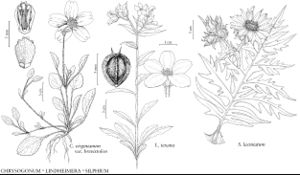Lindheimera
Proc. Amer. Acad. Arts 1: 47. 1847.
| Taxon | Illustrator ⠉ | |
|---|---|---|
 | Chrysogonum virginianum var. brevistolon Lindheimera texana Silphium laciniatum | Linny Heagy Barbara Alongi Yevonn Wilson-Ramsey |
Annuals, 10–120 (–300+) cm. Stems erect, distally branched. Leaves cauline; mostly alternate (distal sometimes opposite); petiolate (proximal) or sessile; blades mostly lanceolate, oblanceolate, or ovate, bases mostly cuneate, margins coarsely toothed to crenate or ± entire, faces ± scabrellous and/or ± hispid. Heads radiate, borne singly or in (leafy to bracteate) loose, corymbiform arrays. Involucres ± turbinate to hemispheric, 5–12 mm diam. Phyllaries persistent (outer), (8–) 10 in 2 series (outer 4–5 becoming reflexed, usually lance-linear, narrower and shorter than inner). Receptacles an outer ring supporting ray-florets plus an inner column supporting disc-florets, paleate (paleae linear, conduplicate). Ray-florets (4–) 5, pistillate, fertile; corollas lemon to bright-yellow. Disc-florets 12–25+, functionally staminate; corollas dull yellow to brownish, tubes shorter than funnelform throats, lobes 5, deltate. Cypselae obcompressed, oblanceolate to obovate (winged, faces ± scabrous to scabrellous; each shed with its subtending phyllary and 2 contiguous paleae with their florets); pappi 0 (shoulders of cypsela wings often projecting as deltate to cornute processes, sometimes interpreted as pappus). x = 8.
Distribution
sc United States, n Mexico
Discussion
Species 1.
Selected References
None.
Lower Taxa
"broader" is not a number.